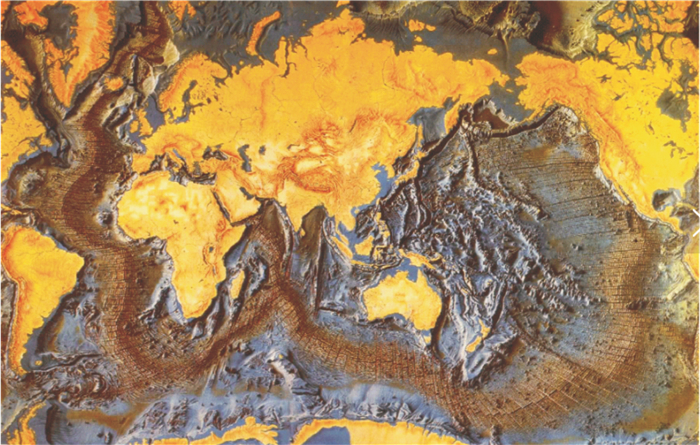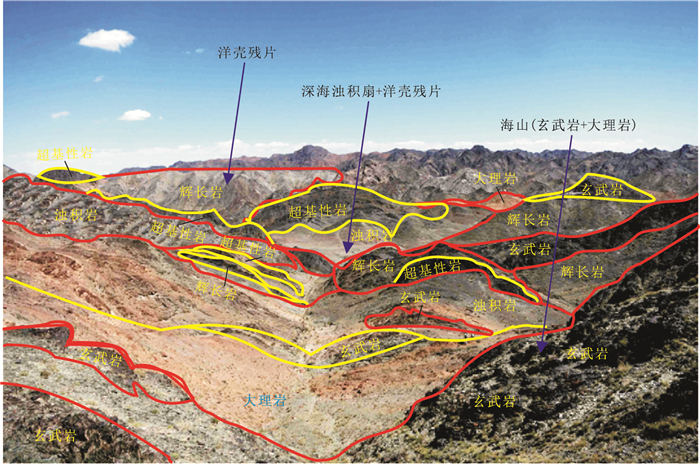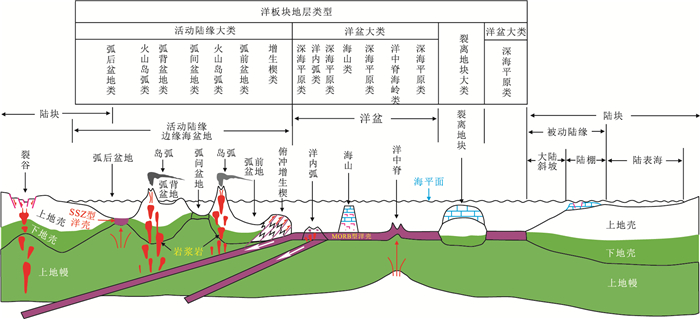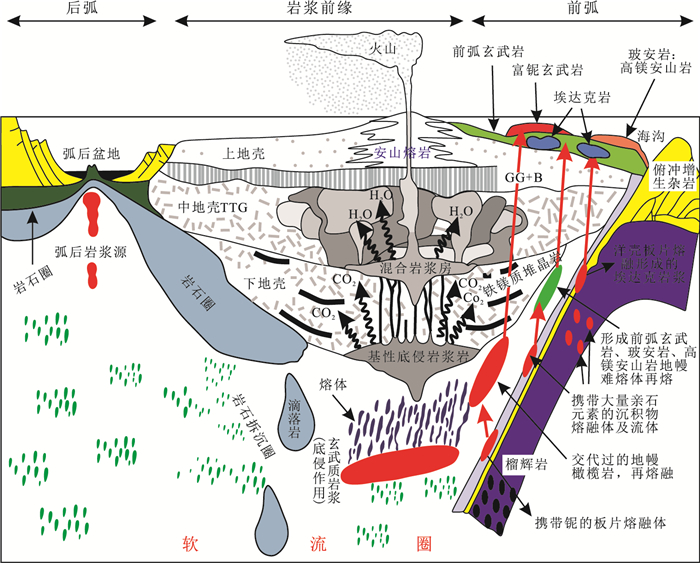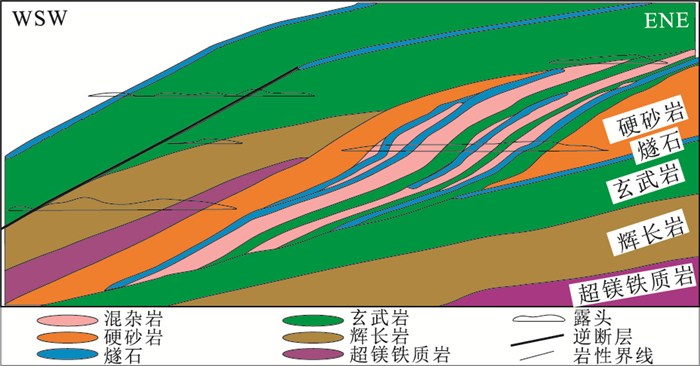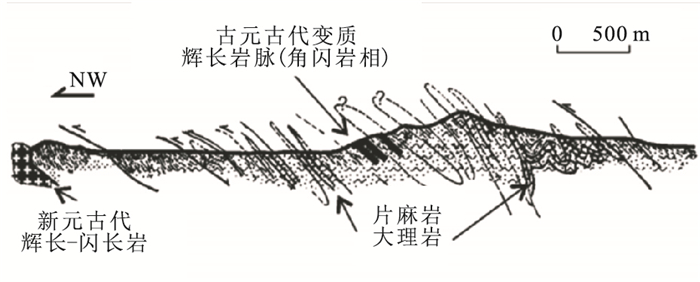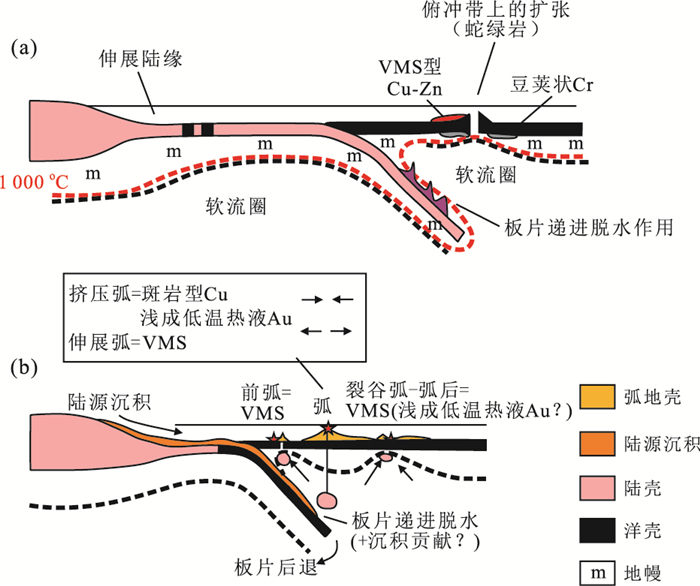A Consideration about the Development of Ocean Plate Geology
-
摘要: 为揭示造山带物质组成和结构构造,发展洋板块地质学,阐明大陆形成演化过程和动力来源,应用板块构造理论和地质学方法,对造山带俯冲增生杂岩带、蛇绿岩带等大洋岩石圈板块地质建造、结构构造进行系统研究,寻找俯冲带岛弧前弧火成岩组合;研究洋板块初始俯冲过程中,从前弧玄武岩到玻安岩、高镁安山岩,再到弧拉斑玄武岩和钙碱性熔岩的岩浆作用分阶段递进演变历史,以揭示洋盆向大陆转化的原始弧性质和前弧火成岩组合及洋陆转换过程,为建立和发展洋板块地质学奠定科学基础.Abstract: In order to reveal the material composition and the structure of the orogenic belt, we propose the ocean plate geology, which is used to explain the process of continental formation and evolution and the source of dynamics. Based on the theory of plate tectonics and geological research methods, the subduction-accretionary complex, the ophiolite belt, and other oceanic lithospheric plate geological formations and structure construction in the orogenic belt are systematically studied in order to find the igneous rock association of the front arc in the subduction zone. In the initial subduction process of the ocean plate, the magmatism from the forearc basalts (FAB) to the boninite, high-Mg andesite (HMA), to the arc tholeiite and calc-alkaline lava and its different stage evolution, are studied in order to identify the characteristics of the original arc and front arc igneous rock association, which reveals the ocean-continent transition in the evolution process from ocean basin to the continent, laying a scientific foundation for the establishment and development of ocean plate geology.
-
1. 地质环境概况
巴东地区地形上属于鄂西中高山长江三峡河谷地貌, 相对高差220~300 m, 地势上北岸较缓, 坡角约20°~35°; 南岸较陡, 坡角约35°~65°, 长江枯水位约66.5 m, 一般洪水位90 m.桥位区地处亚热带季风性气候区, 雨量充沛, 多暴雨, 年平均降雨量1 347.6 mm, 日最大降雨量可达193.3 mm.桥位区基岩地层为中三叠统巴东组第三段(T2b3) 泥质灰岩与泥灰岩互层夹灰岩及第二段(T2b2) 粉砂质泥岩夹粉砂岩.区内断层发育且规模较小, 多为节理、劈理密集带, 破碎带宽达4~5 m, 以近SN向和近EW向为主.岩体中节理、劈理十分发育, 计有4组节理和一组近EW向的劈理.桥位区滑坡崩塌较发育, 多以小型浅表层土石崩滑为主, 未见大型深层滑坡, 岩体风化较严重, 岩体破碎, 对大桥建设影响较大.
2. 岩体结构特征及岩体工程性质
根据野外结构面实测及计算机结构面网络模拟(图 1), 可知: 区内岩体中普遍发育4~5组节理, 节理倾角较陡; 结构面连通性较好, 多张开, 隙宽多在5 mm以下, 结构面线密度一般为0.7~3.2条/m; 岩体结构主要为层状结构及层状碎裂结构[1, 2].
根据各类岩体工程地质特征及实验资料, 将区内岩体划分为4个工程地质岩组.分别采用RMR和Q分类方法对各岩组进行岩体分类, 利用分类中的RMR值、Q值和Hock-Brown法估算出岩体的强度方程如图 2所示.各类岩体计算参数建议值见表 1.
表 1 桥位区岩体力学计算参数建议值Table Supplementary Table Rock mechanics parameters proposed
3. 桥位区斜坡稳定性分析
3.1 滑坡稳定性及其对大桥的影响
根据地质调查稳定性分析, 桥位区发现的滑坡目前以局部浅表层碎石及土的崩滑为主, 在三峡库水作用特别是当库水位反复波动及地震作用下, 滑坡体中下部(太矶头东滑坡、西瀼口滑坡), 甚至全部(唐家湾滑坡) 处于库水浸泡下, 可能诱发滑坡, 对大桥有一定的影响.主要表现在当滑坡整体失稳时产生的波浪冲击桥墩及其岩基, 另外桥两侧滑坡失稳后的地形变化也将对长江水流及轴线斜坡稳定性产生一定的影响.特别是西瀼口与唐家湾两处滑坡分别紧邻桥轴线东、西两侧, 距轴线距离最近仅50 m左右, 其影响尤应注意[3].
3.2 斜坡稳定性分析
3.2.1 弹塑性非线性有限元分析
其力学模型和网格剖分见图 3.考虑岩体自重、桥荷重、水压力、长江水位变化及地震等因素组合共10种计算方案, 结果如图 4所示.
(1) 长江北岸.斜坡初始应力场及初始位移场由自重荷载形成, 后期各种状态下的应力场及初始位移场是后期荷载作用与初始应力场叠加的结果.最大主应力方向与坡面一致; 在库水位上升或下降时, 坡脚、靠近坡面处应力及位移有所变化; 在叠加地震力桥墩荷载作用下, 应力及位移都普遍增大, 主桥墩作用的应力影响深度大约60 m左右.稳定性分析可以看出, 无江水和地下水作用时, 江北斜坡稳定性较好, 在坡体中几乎没有失稳的区域.仅在斜坡内部可见一稳定性系数为1.0的区域, 这一区域没有延伸到斜坡表面, 说明仅仅是斜坡内部岩体的屈服; 当水位上升和骤降时, 斜坡整体稳定性较好; 在叠加地震力作用下, 斜坡稳定性有所降低, 但整体上也是稳定的; 在考虑桥墩荷载作用时, 斜坡的稳定性系数有所减小, 但对斜坡的整体稳定性影响较小; 当水位骤降且叠加地震力作用时, 在软弱破碎帯和T2b2与T2b3交界面处稳定性系数为1或小于1, 边坡处于不稳定状态.
(2) 长江南岸.斜坡初始应力场及初始位移场也是自重荷载形成, 后期各种状态下的应力场及初始位移场是后期荷载作用与初始应力场叠加的结果.在靠近坡面处, 大主压应力方向与坡面一致.在库水位骤降时, 应力在坡脚和坡面处有减小的趋势, 其他部位变化不大; 在桥墩荷载叠加地震力作用下, 斜坡内应力及位移明显增大; 主桥墩作用的应力影响深度大约为50 m左右.稳定性分析可以看出, 无水作用下, 斜坡稳定性较好, 坡体中几乎没有失稳区域; 当水位上升时, 由于水的作用, 使斜坡稳定性系数发生变化, 但斜坡整体稳定性系数较高; 当水位骤降时, 斜坡整体稳定性较好; 在叠加地震力作用下, 斜坡稳定性有所降低, 但整体上是稳定的; 在桥墩荷载作用下, 斜坡的稳定性系数有所减小, 但斜坡仍处于基本稳定状态.
3.2.2 块体极限平衡法分析
据地质调查构成斜坡潜在滑动面的有如下几种, 即T2b2与T2b3岩层交界面; 软弱破碎带; 第四系与基岩的接触面等.据此确定斜坡稳定性计算模型如图 5.考虑岩体自重、桥荷重、水压力、长江水位变化及地震等因素组合共24种计算方案.计算结果表明: 北岸斜坡稳定性在天然状况下, 斜坡处于稳定状态.6个潜在滑动面的稳定性系数都大于1.8;水库运行期间, 斜坡处于基本稳定状态; 考虑不同水库水位、水位骤降及所有桥墩荷载及地震力同时作用时, 斜坡有发生整体失稳的可能.鉴于此, 建议桥墩基础桩穿过T2b3与T2b2界面, 以微风化基岩为持力层.南岸斜坡稳定性在天然状况下, 处于稳定状态; 水库运行期间, Qme抛土处于失稳状态, 建议对此进行清除.其他滑面处于稳定状态; 当水库水位骤降且叠加地震力时, 处于基本稳定状态[3].
4. 桥墩基础地基稳定性分析
4.1 扩大墩基础地基稳定性评价
根据桥位工程地质条件, 选择微风化和新鲜基岩作为桥墩台基础持力层.依据岩体力学性质参数及岩石室内试验数据为基础, 提出岩体地基的承载力建议值如表 2所示.
表 2 桥位区岩体承载力Table Supplementary Table Rockmass capacity in bridge site
4.2 扩大墩基础基坑边坡稳定性评价
据设计主桥墩基础面积约36×26 m2, 基础深度北岸30 m左右, 南岸20 m左右.据稳定性分析: 北岸基坑南帮边坡为逆向坡, 边坡整体稳定性较好, 不会发生大规模失稳现象; 东、西帮为斜交坡, 基坑稳定性相对较好; 基坑北帮边坡为切脚顺向坡, 边坡稳定性差, 在自重作用下就可能发生失稳, 须采取防护加固措施.南岸主桥墩处岩层平缓, 基坑边坡除可能沿人工堆土与基岩接触面产生破坏外, 其整体稳定性较好, 不会产生大规模的滑动破坏.
4.3 桥墩基础类型比较与选择
根据综合分析和评价可知: 桩基础方案优于扩大墩基础方案.其优点在于: (1) 桩基础为深基础, 可穿过浅部的风化破碎岩体及对边坡稳定性不利的软弱破碎带和T2b3与T2b2界面, 将基础置于微风化完整基岩之上; (2) 对岩体扰动少, 可保持岩体原有完整性及强度.
5. 结论
(1) 桥位区工程地质条件十分复杂, 岩体中节理、劈理等结构面十分发育, 岩体完整性、物理力学性质及抗水性差, 是影响桥墩基础及斜坡稳定性的主要因素; (2) 大桥轴线部位斜坡在自然状态下处于稳定状态, 在三峡水库库水作用下边坡稳定性虽有所降低, 但仍是稳定的.然而在大桥荷载作用下, 北岸稳定性差, 特别是在三峡水库水位反复波动并叠加地震力下, 有可能产生较大规模的失稳破坏.经验算其可能滑动面为T2b2与T2b3界面及T2b3内的软弱破碎带.南岸除抛土外, 边坡整体稳定性较好; (3) 经全面比较建议桥墩采用桩基础, 桩深度应尽量穿过T2b2与T2b3界面.
-
图 1 湖北大洪山地质图及其洋板块岩石组合
图a, b据孔令耀等(2017);图c~f据胡正祥等(2015);a, b.湖北省大洪山晋宁期造山带地质图;c.海山:大理岩-玄武岩组合;d.洋岛辉长岩组合;e.枕状玄武岩;f.深海硅质岩.图a中:F1.武山-宝鸡断裂;F2.洛南-栾川-方城断裂;F3.勉略-青峰-襄广断裂;SF1.商丹断裂;图b中:FO1.三里岗-三阳断裂;FO2.黄家湾-小阜-太阳寺断裂;FO3.柳树湾-梅关-破岩山断裂
Fig. 1. Geological map and oceanic plate rock assemblage of Dahongshan in Hubei Province
图 3 甘肃北山马鬃山俯冲增生杂岩
Fig. 3. Subduction-accretionary complex of Mazongshan, Beishan, Gansu Province
图 7 南阿拉斯加格雷维克OPS叠瓦和双重构造剖面
Fig. 7. Imbricate and duplex structural profiles of Gravik OPS in South Alaska
图 8 陈蔡群俯冲增生杂岩中呈叠瓦状的构造变形
Fig. 8. The imbricate structural deformation in the subduction accretion complex of Chencai Group
图 9 洋内弧不同构造单元、不同构造演化历程控制不同类型成矿作用示意
据Herrington and Brown(2011).a.洋内弧早期阶段以基性岩和超基性岩为容矿母岩的VMS型Cu-zn矿床和SSZ型蛇绿岩中基性岩和超基性岩为容矿母岩的铬矿床;b.洋内弧晚期阶段形成的以伸展构造控矿为主的VMS型Cu-Au矿床
Fig. 9. Schematic maps of different types of metallogenesis controlled by different tectonic units and evolutionary processes in intra-oceanic arcs
-
Bao, P.S., Su, L., Wang, J., et al., 2015.The Yarlung Zangbo Ophiolite.Geological Publishing House, Beijing, 227-233(in Chinese). Bierlein, F.P., Groves, D.I., Cawood, P.A., 2009.Metallogeny of Accretionary Orogens-The Connection between Lithospheric Processes and Metal Endowment.Ore Geology Reviews, 36:282-292. doi: 10.1016/j.oregeorev.2009.04.002 Bierlein, F.P., Groves, D.I., Goldfarb, R.J., et al., 2006.Lithospheric Controls on the Formation of Provinces Hosting Giant Orogenic Gold Deposits.Mineralium Deposita, 40:874-887. doi: 10.1007/s00126-005-0046-2 Chen, C., Mao, X.W., Hu, Z.X., et al., 2017.Discovery of ~817 Ma Oceanic Island Basalts in the Dahongshan Region, Northern Hubei Province and Its Significance.Geological Science and Technology Information, 36(6):22-31(in Chinese with English abstract). http://en.cnki.com.cn/Article_en/CJFDTOTAL-DZKQ201706004.htm Cheng, Y.Q., Wang, H.Z., 2006.A Dictionary of Earth Science:Basic Sciences.Geological Publishing House, Beijing, 794(in Chinese). Dilek, Y., Furnes, H., 2011.Ophiolite Genesis and Global Tectonics:Geochemical and Tectonic Fingerprinting of Ancient Oceanic Lithosphere.Geological Society of America Bulletin, 123(3-4):387-411. https://doi.org/10.1130/b30446.1 Dilek, Y., Robinson, P.T., 2003.Ophiolites in Earth History.Geological Society, London, Special Publications, 218:9-19. doi: 10.1144/GSL.SP.2003.218.01.02 Feng, Y.M., Zhang, Y., 2018.Introduction and Commentary on Ocean Plate Stratigrapgy.Geological Bulletin of China, 37(4):523-531(in Chinese with English abstract). http://d.old.wanfangdata.com.cn/Periodical/zgqydz201804001 Herrington, R.J., Brown, D., 2011.The Generation and Preservation of Mineral Deposits in Arc-Continent Collision Environments.Frontiers in Earth Sciences, (Chapter 6): 145-159.https://doi.org/10.1007/978-3-540-88558-0 Hu, Z.X., Mao, X.W., Tian, W.X., et al., 2015.Discovery of the Jinningian Orogenic Belt on the Northern Margin of Yangtze Craton in Mountain Dahong.Geological Survey of China, 2(2):33-39(in Chinese with English abstract). http://en.cnki.com.cn/Article_en/CJFDTotal-DZDC201502006.htm Huang, J.Q., Chen, B.W., 1987.The Evolution of the Tethys in China and Adjacent Regions.Geological Publishing House, Beijing, 71-74(in Chinese). Hutchison, J.S., Goldman, B.D., 1975.The Relationship between the Rat of Testosterone Infusion and Gonadotropin Secretion.Endocrinology, 97(3):725-730. doi: 10.1210/endo-97-3-725 Isozaki, Y., Maruyama, S., Furuoka, F., 1990.Accreted Oceanic Materials in Japan.Tectonophysics, 181(1-4):179-205. https://doi.org/10.1016/0040-1951(90)90016-2 Kong, L.Y., Mao, X.W., Chen, C., et al., 2017.Chronological Study on Detrital Zircons and Its Geological Significance from Mesoproterozoic Dagushi Group in the Dahongshan Area, North Margin of the Yangtze Block.Earth Science, 42(4):485-501(in Chinese with English abstract). https://doi.org/10.3799/dqkx.2017.039 Kusky, T.M., Windley, B.F., Safonova, I., et al., 2013.Recognition of Ocean Plate Stratigraphy in Accretionary Orogens through Earth History:A Record of 3.8 Billion Years of Sea Floor Spreading, Subduction, and Accretion.Gondwana Research, 24(2):501-547. https://doi.org/10.1016/j.gr.2013.01.004 Li, S.G., 2016.Astronomy, Geology, Palaeontology.Geological Publishing House, Beijing, 127-134(in Chinese). Li, T.D., 1998.Polymetallic Nodules.In: Chen, S.P., ed., Earth System Science.China Science and Technology Press, Beijing, 420(in Chinese). Li, T.D., 2010.The Works of Li Tingdong.Geological Publishing House, Beijing, 1246(in Chinese with English abstract). Li, Z.X., 2015.Summary of Tectonic Evolution in South China:Plate Tectonics, Geological Events and Resource Effects.Science Publishing House, Beijing, 54-88(in Chinese). Maruyama, S., Kawai, T., Windley, B.F., 2010.Ocean Plate Stratigraphy and Its Imbrication in an Accretionary Orogen:The Mona Complex, Anglesey-Lleyn, Wales, UK.Geological Society, London, Special Publications, 338(1):55-75. https://doi.org/10.1144/sp338.4 Mo, J., 2004.Frotiers on Marine Geoscience.China Ocean Press, Beijing (in Chinese). Pan, G.T, Xiao, Q.H., 2016.Explanatory Note to the Tectonic Map of China (1:2 500 000).Geological Publishing House, Beijing (in Chinese). Safonova, I., Biske, G., Romer, R.L., et al., 2016.Middle Paleozoic Mafic Magmatism and Ocean Plate Stratigraphy of the South Tianshan, Kyrgyzstan.Gondwana Research, 30:236-256. https://doi.org/10.1016/j.gr.2015.03.006 Safonova, I.Y., Santosh, M., 2014.Accretionary Complexes in the Asia-Pacific Region:Tracing Archives of Ocean Plate Stratigraphy and Tracking Mantle Plumes.Gondwana Research, 25(1):126-158. https://doi.org/10.1016/j.gr.2012.10.008 Wakita, K., Metcalfe, I., 2005.Ocean Plate Stratigraphy in East and Southeast Asia.Journal of Asian Earth Sciences, 24(6):679-702. https://doi.org/10.1016/j.jseaes.2004.04.004 Wang, X.B., Bao, P.S., Deng, W.M., et al., 1987.The Ophiolite in Tibet.Geological Publishing House, Beijing (in Chinese). Xiao, Q.H., Li, T.D., Pan, G.T., et al., 2016.Petrologic Ideas for Identification of Ocean-Continent Transition:Recognition of Intra-Oceanic Arc and Initial Subduction.Geology in China, 43(3):721-737(in Chinese with English abstract). Xiao, X.C., Li, T.D., 2000.Mechanism of Tectonic Evolution and Uplift of the Qinghai-Tibet Plateau.Guangdong Science and Technology Press, Guangzhou (in Chinese). Yan, Z., Wang, Z.Q., Fu, C.L., et al., 2018.Characteristics and Thematic Geological Mapping of Mélanges.Geological Bulletin of China, 37(2):167-191(in Chinese with English abstract). http://en.cnki.com.cn/Article_en/CJFDTotal-ZQYD2018Z1001.htm Zhang, J., Deng, J.F., Xiao, Q.H., et al., 2012.New Advances in the Study of Ophiolites.Geological Bulletin of China, 31(1):1-12(in Chinese with English abstract). http://en.cnki.com.cn/Article_en/CJFDTotal-ZQYD201201000.htm Zhang, K.X., He, W.H., Xu, Y.D., et al., 2016.Palaeogeographic Distribution and Tectonic Evolution of OPS in China.Earth Science Frontiers, 23(6):24-30(in Chinese with English abstract). http://d.old.wanfangdata.com.cn/Periodical/dxqy201606002 Zhang, K.X., He, W.H., Xu, Y.D., et al., 2018.Tectonic-Stratigraphic Division and Sedimentary Tectonic Evolution in China (in Chinese). Zhang, K.X., Yin, H.F., Zhu, Y.H., et al., 2001.Theory, Methodology and Practice of Geological Mapping in Mélange Terrains of Orogenic Belts:A Case Study of the East Kunlun Orogenic Belt.China University of Geosciences Press, Wuhan (in Chinese). Zhang, W.Y., 1986.Tectonics of Land and Sea in China and Adjacent Areas.Science Press, Beijing, 444-479(in Chinese). 鲍佩声, 苏犁, 王军, 等, 2015.雅鲁藏布江蛇绿岩.北京:地质出版社, 227-233. 陈超, 毛新武, 胡正祥, 等, 2017.鄂北大洪山地区~817 Ma洋岛玄武岩的发现及意义.地质科技情报, 36(6):22-31. 程裕淇, 王鸿祯, 2006.地质科学大辞典(基础学科卷).北京:地质出版社, 794. 冯益民, 张越, 2018.大洋板块地层(OPS)简介及评述.地质通报, 37(4):523-531. http://www.cnki.com.cn/Article/CJFDTotal-ZQYD201804001.htm 胡正祥, 毛新武, 田望学, 等, 2015.扬子陆块北缘大洪山地区发现晋宁期造山带.中国地质调查, 2(2):33-39. http://d.old.wanfangdata.com.cn/Periodical/zgdzdc201502004 黄汲清, 陈炳蔚, 1987.中国及邻区特提斯海的演化.北京:地质出版社, 71-74. 孔令耀, 毛新武, 陈超, 等, 2017.扬子北缘大洪山地区中元古代打鼓石群碎屑锆石年代学及其地质意义.地球科学, 42(4):485-501. http://earth-science.net/WebPage/Article.aspx?id=3563 李四光, 2016.天文·地质·古生物.北京:地质出版社, 127-134. 李廷栋, 1998.多金属结核.见: 陈述彭, 编, 地球系统科学.北京: 中国科学技术出版社, 420. 李廷栋, 2010.李廷栋文集(中卷).北京:地质出版社, 1246. 李正祥, 2015.华南大地构造演化综述:板块构造、地质事件与资源效应.北京:科学出版社, 54-88. 莫杰, 2004.海洋地学前缘.北京:海洋出版社. 潘桂棠, 肖庆辉, 2016.中国大地构造图(1:2500 000)说明书.北京:地质出版社. 王希斌, 鲍佩声, 邓万明, 等, 1987.西藏蛇绿岩.北京:地质出版社. 肖庆辉, 李廷栋, 潘桂棠, 等, 2016.识别洋陆转换的岩石学思路——洋内弧与初始俯冲的识别.中国地质, 43(3):721-737. http://www.wanfangdata.com.cn/details/detail.do?_type=perio&id=zgdizhi201603003 肖序常, 李廷栋, 2000.青藏高原的构造演化与隆升机制.广州:广东科技出版社. 闫臻, 王宗起, 付长垒, 等, 2018.混杂岩基本特征与专题地质填图.地质通报, 37(2):167-191. doi: 10.3969/j.issn.1671-2552.2018.02.001 张进, 邓晋福, 肖庆辉, 等, 2012.蛇绿岩研究的最新进展.地质通报, 31(1):1-12. doi: 10.3969/j.issn.1671-2552.2012.01.001 张克信, 何卫红, 徐亚东, 等, 2016.中国洋板块地层分布及构造演化.地学前缘, 23(6):24-30. http://www.cnki.com.cn/Article/CJFDTotal-DXQY201606007.htm 张克信, 何卫红, 徐亚东, 等, 2018.中国构造-地层区划与沉积大地构造演化报告. 张克信, 殷鸿福, 朱云海, 等, 2001.造山带混杂岩区地质填图理论、方法与实践:以东昆仑造山带为例.武汉:中国地质大学出版社. 张文佑, 1986.中国及邻区海陆大地构造.北京:科学出版社, 444-479. -











 下载:
下载:





 下载:
下载:
